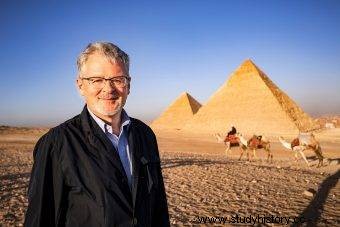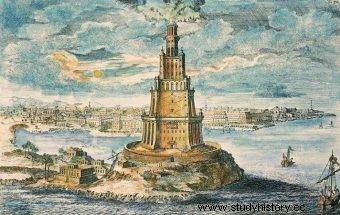The most magnificent buildings of the ancient world. We know them mainly from accounts, because only one of these structures has survived to modern times. The Seven Wonders of the Ancient World is a lockpick. Everyone knows about them, but can you name them without thinking?
We know them mainly from ancient and medieval accounts and their representations on coins. All of them were created by man and were the most visited places of the ancient world. The oldest known list of the seven top places that every self-respecting person should visit at that time was created in the 2nd century BCE. the Greek poet Antipater of Sidon. Diodorus Siculus also mentioned them. We owe the modern version to medieval sources, based on ancient sources.
Great Pyramid
The Cheops Pyramid is one of the wonders of the ancient world that we can admire to this day. It was built for the Pharaoh of the 4th Dynasty around 2560 BCE. on artificially leveled terrain. The building originally reached a height of about 146.72 m. With time, however, it lost its facing and its "tip" called a pyramidion, which is why today it reaches 138.75 m.
The Great Pyramid is an extraordinary structure. Constructed of huge stone blocks weighing from 2.5 to 15 tons, still impresses and raises questions about the technology that was used to erect it . Another remarkable thing is the fact that it has three burial chambers. It was discussed many times. Some even looked for "chambers of knowledge" filled with treasures in them.

Polsat Viasat History "Treasure Planet". Premiere August 8 at 19:55.
The most spectacular element of the Cheops pyramid is the great gallery which is an extension of the corridor leading to the main thunder chamber. Its walls are made of polished limestone and are 2.28 meters high.
The Hanging Gardens of Babylon
Built by order of the Babylonian king Nebuchadnezzar II (604–562 B.C.E.), they were a gift for his wife, Amytis. They were to soothe the wife's longing for the hills and valleys of her native country. Their name refers to the legend of Semiramis who was to rule Babylon in the 9th century B.C.
These amazing gardens were erected on terraces and created barrel-vaulted corridors. In places where plants were planted, a special type of tar and lead insulation was used. There was a drainage layer on top of it, then covered with even a 2-meter layer of earth. The whole structure also had an artificial irrigation system for which the waters of the Euphrates were used.
Temple of Artemis in Ephesus
It was known to the ancients as Artemision. It was dedicated to the Greek goddess of hunting, animals and nature - Artemis. It was built around 550 BC. by order of the Lydian king Croesus and probably stood on the site of an earlier building. The "Hymn to Artemis" suggests that the original structure may have been dedicated to the mythical Amazons.
The Ionian temple was made of fine marble and Lebanese cedar. It was decorated with many sculptures, and was crowned with a cedar statue of Artemis. The construction involved sculptors such as Phidias, Polykleitos and Kresilas and took 120 years.
The first temple was destroyed in a fire set by the shoemaker Herostrates, who wanted to become famous because of it. Alexander the Great wanted to finance its reconstruction, but the inhabitants of Ephesus refused him this, saying:"Alexander, it is not fitting for one god to build temples for another god."
The temple was rebuilt on the foundations of the previous one. Work began around 323 BCE, and the building was graced with a statue of the goddess Artemis made of gold, silver, ivory, ebony wood and black stone. The temple was destroyed during the Goth invasions in 268 CE. and it was never rebuilt.
Statue of Zeus at Olympia
The statue of Zeus, about 13 meters high, was made by Phidias in the 5th century BC. It was supposed to depict a god sitting in a dignified position on a throne. His head was decorated with a wreath of olive branches, he was holding the goddess Nike in his right hand and a scepter lined with precious stones in his left hand.

Image of the statue of Zeus
Phidias used the best materials to make his work. The elements of the sculpture are placed on a wooden base. The face and exposed parts of the body were most likely made of ivory. The robe and hair are covered with gold, the divine throne is made of cedar wood inlaid with ebony and precious stones.
The statue was transported in parts and placed in its final location. Legend has it that Phidias after the whole undertaking asked Zeus in prayer if he liked the work. At that moment lightning struck the ground in front of the statue. This sign was read as acceptance.
Mausoleum at Halicarnassus
This extraordinary tomb of the Persian satrap Mausolus was erected by Queen Artemisia around 350 BCE. It was built on a hill to dominate the neighboring city. The mausoleum was 45 meters high, it consisted of a platform, a part surrounded by colonnades and ended with a pyramidal structure. The building was decorated with bas-reliefs and sculptures.
The construction and decoration of the mausoleum were so elaborate that its construction must have started before the death of the Mausoleum. One of the remarkable finds from the ruins of this object is the "jar of Xerxes I". This alabastrone, made of calcite or alabaster, came from Egypt and was an extremely expensive and important item.
Colossus of Rhodes
This 30-32-meter statue was made by the Greek sculptor Chares of Lindos. It was placed on a 10-meter pedestal as a reminder of the unsuccessful siege of Rhodes by the army of the great commander Demetrius Poliorketes in the years 305-304 BCE
It depicted the Greek sun god - Helios, and was made of bronze. About 12.7 tons of this raw material and about 7.6 tons of iron were used for its construction, from which the skeleton of the statue was made. For stability, the skeleton is filled with clay and stones. Helios' eyes were adorned with precious stones.
The statue was destroyed in 227/226 BCE. during an earthquake. This event was recalled by Strabo with the words:"the statue was lying on the ground, knocked down by an earthquake and broken in the knees". Due to unfavorable predictions, the oracle of the statue was not rebuilt. It lay where it fell until the Arabs sold it for scrap.
Faros Lighthouse
In the time of Ptolemy I and his son Ptolemy II, i.e. around 280-279 BCE. On the islet of Pharos, near the port of Alexandria, an unusual structure was erected. The most famous lantern in the ancient world was designed by the architect Sostratos. We know his name from the inscription preserved under the ancient plaster:"Sostratus, son of Deksyfsnes, dedicated this building to the gods of salvation, on behalf of all those who sail the seas ”.
The lighthouse could be about 120 meters high and consisted of three storeys. The lower one, with a square cross-section, was the basis for another one with an octagonal cross-section. Everything was crowned with a third, round part ended with a dome. A statue of Poseidon - the Greek god of the seas and oceans - was to be placed on the top.

Faros lighthouse
After dark, a fire was lit at the top of the lantern, the glow of which was then reflected by metal mirrors. The structure was damaged by earthquakes, and its upper part probably collapsed in the 2nd century CE. The building was then converted into a mosque. The lighthouse also suffered in subsequent earthquakes, and eventually its remains were dismantled and used for the construction of the fort.
There have been efforts to add many structures over the years to the list of wonders of the ancient world, but they have never been universally accepted. In subsequent epochs, further lists were created that illustrated the changing world. The latest Polsat Viasat History series, "Planet of the Treasures", tells about unusual places worth visiting. Premiere August 8 at 19:55.
Literature:
- P.A. Clayton, M.J. Price, The Seven Wonders of the Ancient World, London / New York 2002.
- Szolgina, Architecture , Warsaw 1992.
- Alabastron, The British Museum Collection. Number 132114.
